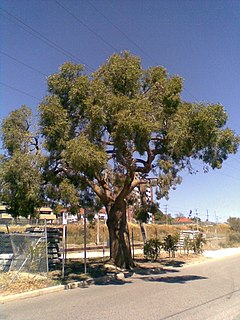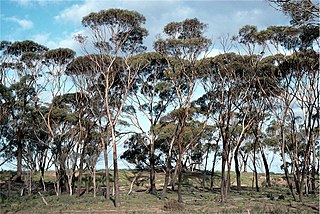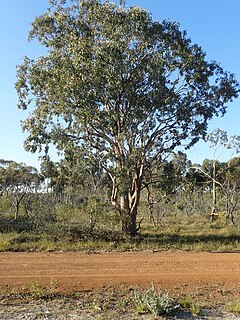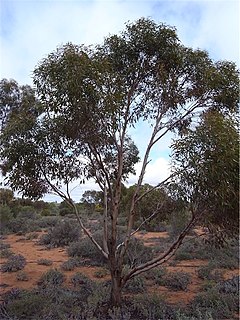
Eucalyptus youngiana, commonly known as large-fruited mallee, Ooldea mallee and yarldarlba, is a species of mallee, less commonly a tree, that in native to arid and semi-arid areas of southern Western Australia and South Australia. It has rough, fibrous bark on some or all of the trunk, smooth bark above, lance-shaped adult leaves, flower buds in groups of three, red, pink or bright yellow flowers and short, broad, conical fruit.

Eucalyptus todtiana, commonly known as coastal blackbuttpricklybark or dwutta, is a species of tree or a mallee that is endemic to the west coast of Western Australia. It has rough, fibrous and flaky bark on the trunk, smooth bark on the branches, lance-shaped adult leaves, flower buds in groups of between seven and eleven, white flowers and cup-shaped to hemispherical fruit.

Eucalyptus andrewsii, commonly known as the New England blackbutt, is a tree native to New South Wales and Queensland in eastern Australia. It is a tree with rough bark on the trunk and larger branches, lance-shaped often curved leaves, flower buds in groups of between eleven and fifteen and hemispherical or cup-shaped fruit.

Eucalyptus staeri, commonly known as Albany blackbutt, is a species of small tree or a mallee and is endemic to the south-west corner of Western Australia. It has rough bark on the trunk and branches, thick, lance-shaped adult leaves, flowers buds in groups of between seven and fifteen, creamy white flowers and shortened spherical fruit.

Eucalyptus comitae-vallis, commonly known as Comet Vale mallee, is a mallee that is endemic to the south-west of Western Australia. It has rough, flaky to ribbony bark on the trunk and larger branches, smooth withish bark above, linear to narrow lance-shaped adult leaves, flower buds in groups of seven to eleven, white flowers and barrel-shaped, conical or cup-shaped fruit.

Eucalyptus georgei, commonly known as Hyden blue gum, is a species of tree or mallet that is endemic to Western Australia. It has smooth bark, glossy green, lance-shaped adult leaves, glaucous flower buds in groups of between seven and eleven, creamy white flowers and conical to cup-shaped fruit.

Eucalyptus griffithsii, commonly known as Griffith's grey gum, is a species of mallee or tree that is endemic to Western Australia. It has smooth grey to whitish bark, sometimes with rough, loose fibrous bark near the base of the trunk, lance-shaped adult leaves, flower buds in groups of three, white flowers and conical to cup-shaped fruit.

Eucalyptus kondininensis, commonly known as Kondinin blackbutt, is a species of tree that is endemic to Western Australia. It has rough, black bark on the trunk, smooth grey to white bark on the branches, lance-shaped adult leaves, flower buds in groups of seven, white flowers and cup-shaped to conical fruit.

Eucalyptus platycorys, commonly known as Boorabbin mallee, is a species of mallee, rarely a small tree, that is endemic to Western Australia. It has rough, dark grey, fibrous and flaky bark on the trunk, smooth greyish bark above, lance-shaped adult leaves, flower buds usually in group of three, creamy white flowers and cup-shaped to cylindrical fruit.

Eucalyptus sargentii, commonly known as Salt River gum, is a species of mallet, mallee or small tree that is endemic to Western Australia. It has rough bark on part or all of the trunk, smooth bark above, linear to narrow lance-shaped leaves, flower buds in groups of seven, whitish to creamy yellow flowers and conical fruit.

Eucalyptus scyphocalyx, commonly known as goblet mallee, is a species of mallee that is endemic to southern areas of Western Australia. It has smooth bark, lance-shaped adult leaves, flower buds in groups of three or seven, creamy white flowers and cup-shaped to cylindrical fruit.

Eucalyptus sheathiana, commonly known as ribbon-barked gum, is a species of tree or a mallee that is endemic to Western Australia. It has smooth bark that is shed in long ribbons, lance-shaped adult leaves, flower buds in groups of seven, creamy white flowers and conical to cup-shaped fruit.

Eucalyptus striaticalyx, commonly known as Cue York gum or kopi gum, is a species of tree or mallee that is endemic to Western Australia. It has thick, rough, fibrous bark on the trunk and larger branches, lance-shaped adult leaves, flower buds in groups of between seven and thirteen, creamy white flowers and conical to cup-shaped fruit.
Eucalyptus tortilis is a species of mallet and a gimlet that is endemic to the southwest of Western Australia. It has smooth bark, lance-shaped adult leaves, flower buds in groups of seven, creamy white flowers and hemispherical to cup-shaped fruit.

Eucalyptus transcontinentalis, commonly known as redwood or boongul, is a species of small to medium-sized tree, sometimes a mallet, that is endemic to the southwest of Western Australia. It has smooth bark, lance-shaped adult leaves, flower buds usually in groups of seven, pale yellow flowers and urn-shaped to barrel-shaped fruit.

Corymbia cliftoniana is a species of tree that is endemic to northern Australia. It has thick, rough, tessellated bark on the trunk and branches, narrow lance-shaped adult leaves, flower buds in groups of seven, creamy white flowers and shortened spherical fruit.

Corymbia collina, commonly known as the silver-leaved bloodwood, is a species of tree that is endemic to Western Australia. It has thin patchy rough bark on some or all of the trunk, smooth white to pale grey bark above, lance-shaped to curved adult leaves, flower buds in groups of seven, creamy white flowers and barrel-shaped fruit.

Eucalyptus carnei, also known as the Carne's blackbutt, is a species of tree or mallee that is endemic to an area in central Western Australia. It has smooth grey bark, lance-shaped adult leaves, flower buds in groups of seven, creamy white flowers, and cup-shaped to conical fruit.

Eucalyptus dundasii, commonly known as the Dundas blackbutt, is a species of tree that is endemic to Western Australia. It has rough, scaly bark on the lower part of the trunk, smooth bark above, narrow lance-shaped to curved adult leaves, flower buds in groups of seven, creamy white flowers and cylindrical to narrow urn-shaped flowers.

Eucalyptus clelandiorum, commonly known as Cleland's blackbutt is a species of mallet that is endemic to the South West region of Western Australia. It has hard, black, crumbly bark on the lower half of its trunk, smooth bark above, narrow lance-shaped adult leaves, flower buds arranged in groups of seven, nine or eleven, white flowers and cup-shaped fruit.






















